Topiary Park
Topiary Park (officially the Old Deaf School Park) is a 9.2-acre (3.7 ha) public park and garden in Columbus, Ohio's Discovery District. The topiary garden, officially the Topiary Garden at Old Deaf School Park, is designed to depict figures from George Seurat's 1884 painting, A Sunday Afternoon on the Island of La Grande Jatte. It is the only park based entirely on a painting.[1]
| Topiary Park | |
|---|---|
| Old Deaf School Park | |
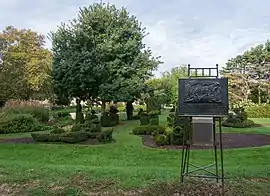 The park's central design, replicating A Sunday Afternoon on the Island of La Grande Jatte | |
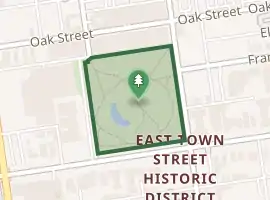
| |
| Type | Urban park |
| Location | Columbus, Ohio, U.S. |
| Coordinates | 39°57′40.0″N 82°59′15.2″W |
| Area | 9.182 acres (3.716 ha) |
| Opened | 1992 |
| Designer |
|
| Administered by | Columbus Recreation and Parks Department |
| Public transit access | |
| Website | Official website |
The park is formally known as Deaf School Park, or Old Deaf School Park, as it was part of the campus of the Ohio School for the Deaf.[2] It is owned by the city of Columbus and maintained by the Columbus Recreation and Parks Department.[3]
Description

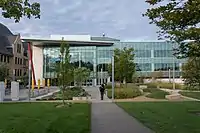
The park is located in downtown Columbus. It features topiaries trimmed into life-size shapes of men, women, children, animals, and boats and arranged to resemble the painting A Sunday Afternoon on the Island of La Grande Jatte.[1][4] Specifically, there are topiaries of 54 people, eight boats, three dogs, a monkey, and a cat.[5] It also hosts 220 trees, including 35 different species.[6] The park hosts jazz concerts.[7]
The park is adjacent to the Main Branch of the Columbus Metropolitan Library system. The branch was renovated around 2015, with one of the architect's goals being to join the library to the park.[8]
The gatehouse, near the southeast corner of the park, is the park's main entrance. The 2,400-square-foot (220 m2) building holds offices, restrooms, and an information desk and gift shop. It was constructed in 1998, designed in brick and resembling a French countryside house to match the park's theme. The building was funded by the City of Columbus, Motorists Mutual Insurance, and the Friends of the Topiary Park.[4][9]
History
The land originated as part of the 10-acre (4 ha) campus of the Ohio School for the Deaf, and a dormitory was built there for the school. When the school moved locations in 1953, the neighborhood declined. Most of the school's buildings burned down in 1981, leading to the development of the park, which helped revitalize the area.[4][2]
The park was first developed in the mid-1980s as Old Deaf School Park.[9] Topiary Park and its garden was conceived by Columbus artists James and Elaine Mason. It was built as a garden exhibit for the AmeriFlora exhibition that took place in Columbus in 1992,[1] and was sculpted in 1989, along with installation of hills and a small pond, meant to represent the River Seine.[2]
Gallery
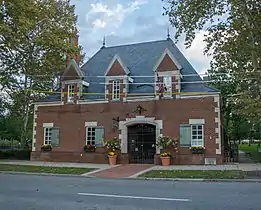 The park's gatehouse
The park's gatehouse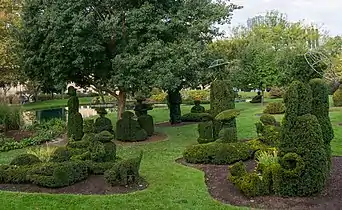 Topiary Garden
Topiary Garden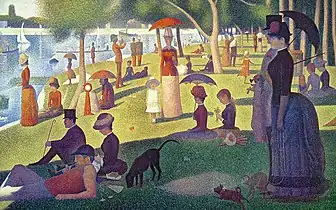 A Sunday Afternoon on the Island of La Grande Jatte
A Sunday Afternoon on the Island of La Grande Jatte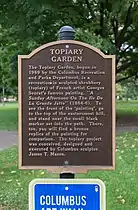 Informational sign
Informational sign Historical marker
Historical marker
See also
References
- Gottsacker, Erin (July 3, 2017). "Curious Cbus: What's The Story Behind Topiary Park?". WOSU Radio. Retrieved October 20, 2018.
- "Topiary Garden (Deaf School Park)". City of Columbus, Ohio. Retrieved October 20, 2018.
- "Home". Topiary Park. Friends of the Topiary Park. Retrieved October 20, 2018.
- Hamper, Anietra (2018). Secret Columbus: A Guide to the Weird, Wonderful, and Obscure. Reedy Press. Retrieved October 20, 2018.
- Hoevener, Laura; Weeks, Terri (2010). Adventures Around Cincinnati. Mill City Press. p. 184. Retrieved October 20, 2018.
- "Old Deaf School Park Tree Walk" (PDF). Friends of the Topiary Park. Retrieved October 20, 2018.
- "Discovery District comes into its own". The Columbus Dispatch. August 31, 2017. Retrieved October 20, 2018.
- "Columbus Metropolitan Library: Main Branch serving downtown Columbus". Schooley Caldwell. Retrieved October 20, 2018.
- Darbee, Jeffrey T.; Recchie, Nancy A. (2008). The AIA Guide to Columbus. Ohio University Press. p. 75. ISBN 9780821416846.
External links
| Wikimedia Commons has media related to Topiary Park. |
- Official website
- Friends of the Topiary Park (Wayback Machine archive)